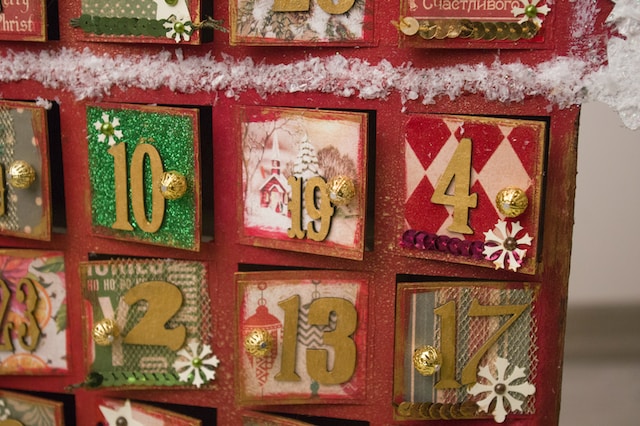Last week I posted a picture on Facebook of an Advent Calendar with the caption, “I don’t care how old you are, you are never too old for one of these!” It sparked an interesting discussion about Advent Calendars. A few people used the comment section under the post, to take a trip down memory lane and reflect on their childhood when Advent Calendars didn’t have chocolates inside each door, but pictures.
That was my experience too.
On December 1st, an Advent Calendar would appear on the fridge of my childhood home in Etobicoke. Remember the excitement of the yet unopened Advent Calendar? Twenty-four doors, each hiding a different symbol of the season; a candle, a drum, a wrapped gift, etc. Each year we would have to decide who got to open the first door. Clad in our pajamas, huddled around the fridge, my brother and sister and I, along with our parents, would discuss the “order of opening”. It seemed to me that we would either go youngest to oldest, or oldest to youngest, which meant as the middle child I always got ripped off. But so is the tragic life of a middle child. Once the opening began, it seemed like we would never get to the last door! Now that I’m a minister, December goes much too quickly, but back then, it was slower than a snail with a broken leg.
I’m sure you too have an Advent Calendar story. If you do, I’d like to hear it. For fun, here are some facts about Advent Calendars:
- Before the advent of the Advent Calendar, children would often mark the days before Christmas with chalk lines on the wall (and you thought that was just something prisoners did!!)
- The first Advent Calendar, in the shape of a clock, appeared in Germany in the 1850’s. Behind it’s twelve numbers, hid verses of Christmas songs.
- The German Lithographer Berhard Lang was credited with creating the first mass produced Advent Calendars in the early 1900’s. The first calendar that included chocolate was made in 1926.
- In the second world war, the Nazi’s banned Advent Calendars and created their own “Pre-Christmas Calendar” that included political propaganda.
- The Advent Calendar made it to North American shores in 1954, popularized by a picture of the grandchildren of President Dwight Eisenhower each holding one.
- Both the biggest and smallest Advent Calendars in the world are in Germany. The biggest is in a town called Gengenbach. It includes a two-story structure with each full-size door hiding a Christmas scene. The smallest was created in 2007. It is a nano-scale etching of snowmen, churches and Christmas gifts, invisible to the human eye. How small is it? You would have to blow it up to five million times its size to make it the size of a postage stamp.
Advent Calendars are just one small way of marking time through this season of waiting and preparing for Christmas. Even if we have outgrown them, we will never outgrow the memory of pulling open that first door and beginning the official journey to Christmas morning.




